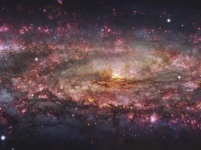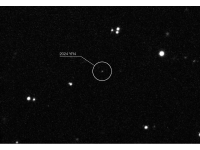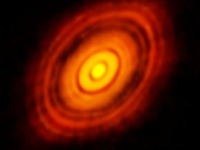Astronomers create dazzling, elaborate map of nearby galaxy in thousands of colours
Author of the article:Associated Press
Associated Press
Marcia Dunn
Published Jun 18, 2025 • 1 minute read
This handout provided by the European Southern Observatory shows a detailed, thousand-colour image of the Sculptor Galaxy captured with the MUSE instrument at ESO's Very Large Telescope (VLT).
This handout provided by the European Southern Observatory shows a detailed, thousand-colour image of the Sculptor Galaxy captured with the MUSE instrument at ESO's Very Large Telescope (VLT). Photo by European Southern Observatory /THE ASSOCIATED PRESS
CAPE CANAVERAL, Fla. — Astronomers have revealed a nearby spiral galaxy in all its brilliant glory, shining in thousands of colours.
The dazzling panoramic shot released Wednesday of the Sculptor galaxy by a telescope in Chile is so detailed that it’s already serving as a star-packed map.
Scientists used the European Southern Observatory’s Very Large Telescope to observe the galaxy for some 50 hours, stitching together more than 100 exposures to create the picture. The image spans 65,000 light-years, almost the entire galaxy. A light-year is 5.8 trillion miles.
Sculptor — officially labelled NGC 253 — is considered a starburst galaxy, one heavy with stellar action. It’s located 11 million light-years away in the Southern Hemisphere’s constellation Sculptor, and easy to view with binoculars or small telescopes.
“The Sculptor galaxy is in a sweet spot,” the observatory’s Enrico Congiu, who led the research, said in a statement. “It is close enough that we can resolve its internal structure and study its building blocks with incredible detail, but at the same time, big enough that we can still see it as a whole system.”
The more shades of colour from stars, gas and dust in a galaxy, the more clues to their age, composition and motion, according to the scientists. Sculptor’s latest snapshot contains thousands of colours — a glowing montage of purples, pinks and yellows — compared with just a handful for traditional pictures.
The team has already discovered 500 planetary nebulae, clouds of gas and dust from dying stars that can serve as cosmic mile markers. Their research has been accepted for publication in the journal Astronomy & Astrophysics.


 torontosun.com
torontosun.com
Author of the article:Associated Press
Associated Press
Marcia Dunn
Published Jun 18, 2025 • 1 minute read
This handout provided by the European Southern Observatory shows a detailed, thousand-colour image of the Sculptor Galaxy captured with the MUSE instrument at ESO's Very Large Telescope (VLT).
This handout provided by the European Southern Observatory shows a detailed, thousand-colour image of the Sculptor Galaxy captured with the MUSE instrument at ESO's Very Large Telescope (VLT). Photo by European Southern Observatory /THE ASSOCIATED PRESS
CAPE CANAVERAL, Fla. — Astronomers have revealed a nearby spiral galaxy in all its brilliant glory, shining in thousands of colours.
The dazzling panoramic shot released Wednesday of the Sculptor galaxy by a telescope in Chile is so detailed that it’s already serving as a star-packed map.
Scientists used the European Southern Observatory’s Very Large Telescope to observe the galaxy for some 50 hours, stitching together more than 100 exposures to create the picture. The image spans 65,000 light-years, almost the entire galaxy. A light-year is 5.8 trillion miles.
Sculptor — officially labelled NGC 253 — is considered a starburst galaxy, one heavy with stellar action. It’s located 11 million light-years away in the Southern Hemisphere’s constellation Sculptor, and easy to view with binoculars or small telescopes.
“The Sculptor galaxy is in a sweet spot,” the observatory’s Enrico Congiu, who led the research, said in a statement. “It is close enough that we can resolve its internal structure and study its building blocks with incredible detail, but at the same time, big enough that we can still see it as a whole system.”
The more shades of colour from stars, gas and dust in a galaxy, the more clues to their age, composition and motion, according to the scientists. Sculptor’s latest snapshot contains thousands of colours — a glowing montage of purples, pinks and yellows — compared with just a handful for traditional pictures.
The team has already discovered 500 planetary nebulae, clouds of gas and dust from dying stars that can serve as cosmic mile markers. Their research has been accepted for publication in the journal Astronomy & Astrophysics.


Astronomers create dazzling, elaborate map of nearby galaxy in thousands of colours
Astronomers have revealed a nearby spiral galaxy in all its brilliant glory, shining in thousands of colours.


![6859600583b2baceebd63117jpeg-e1750689075218[1].jpg 6859600583b2baceebd63117jpeg-e1750689075218[1].jpg](https://forums.canadiancontent.net/data/attachments/28/28034-b9f04c751b232e7925c82f981f4ebd6a.jpg)

![6859600383b2baceebd63116jpeg-e1750689113577[1].jpg](/data/attachments/28/28033-d95c86de549053bba4c41e595306cf96.jpg)











